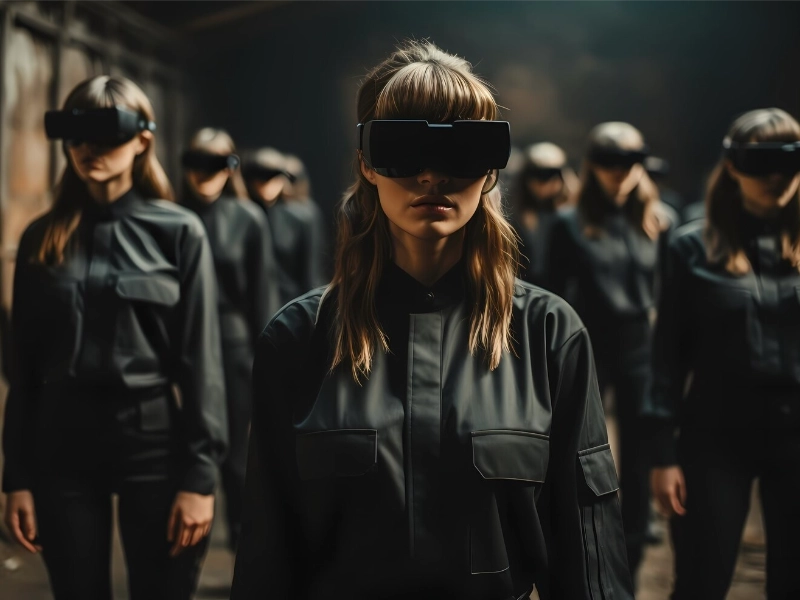- Immersive Virtual Reality (VR) technology creates a simulated environment that engages multiple senses, blurring the line between the physical and digital worlds.
- Enhanced engagement, immersive learning experiences, and therapeutic applications are key benefits of immersive VR technology.
- VR finds applications in entertainment (gaming), education and training, and healthcare, offering diverse experiences across various industries.
Immersive Virtual Reality technology refers to a computer-generated environment that simulates a realistic sensory experience, typically through a head-mounted display and interactive devices. By transporting users into digitally created worlds, VR blurs the line between the physical and digital realms, offering a level of immersion unmatched by traditional media.
Defining immersive VR technology
Immersive Virtual Reality (VR) technology represents a specialised subset within the broader field of Virtual Reality, meticulously crafted to provide users with an elevated sense of presence and engagement within a digital domain. At its core, the term “immersive” in immersive VR underscores its profound ability to engulf users entirely within a three-dimensional (3D) virtual space, blurring the distinction between reality and simulation.
In practical terms, immersive VR systems typically comprise several integral components, each contributing to the overall immersive experience. One such component is the head-mounted display (HMD), a wearable device that serves as the primary interface between the user and the virtual environment. The HMD envelops the user’s field of view with high-resolution displays, ensuring a visually immersive experience. Additionally, motion tracking sensors embedded within the HMD precisely monitor the user’s head movements, allowing for seamless navigation and interaction within the virtual space.
Moreover, handheld controllers complement the immersive VR experience by enabling users to manipulate virtual objects and interact with the environment. These controllers often feature intuitive input mechanisms, such as buttons, triggers, and touchpads, facilitating natural and responsive interactions within the virtual realm.
Furthermore, the immersive nature of VR technology extends beyond mere visual and interactive elements. Advanced audio systems play a crucial role in enhancing immersion by providing spatially accurate sound cues that mimic real-world environments. By accurately replicating auditory cues such as directional sound effects and spatial audio, VR systems create a multi-sensory experience that further blurs the line between the physical and virtual worlds.
Also read: Microsoft Teams introduces immersive 3D and VR meetings
Advantages of immersive VR technology
Immersive VR technology provides users with a level of engagement and interactivity that surpasses traditional media formats. By immersing users in a realistic and interactive virtual environment, VR enables them to become active participants in their digital experiences. Whether exploring virtual worlds, interacting with digital objects, or engaging in immersive storytelling, VR captivates users and fosters deeper engagement with the content.
One of the most significant advantages of immersive VR technology lies in its educational applications. VR simulations can replicate complex scenarios and environments with remarkable accuracy, offering students immersive learning experiences that transcend traditional teaching methods. For example, in the field of science, VR can transport students to distant planets, allowing them to explore celestial bodies and phenomena firsthand. Similarly, in history lessons, VR can recreate historical events and settings, providing students with a visceral understanding of past events. By engaging multiple senses and promoting experiential learning, immersive VR technology enhances comprehension, retention, and overall learning outcomes.
Beyond entertainment and education, immersive VR technology holds immense potential in therapeutic settings. VR-based interventions have been successfully used in various therapeutic applications, including exposure therapy for phobias, pain management, and physical rehabilitation. By creating immersive and controlled environments, VR enables therapists to expose patients to anxiety-inducing stimuli or challenging scenarios in a safe and supportive manner. For individuals struggling with phobias or PTSD, VR exposure therapy offers a gradual and systematic approach to confronting fears and reducing anxiety levels. Additionally, VR-based rehabilitation programs leverage interactive exercises and simulations to facilitate physical recovery and motor skill development in patients recovering from injuries or surgeries. Overall, immersive VR technology enhances therapeutic interventions by providing a customisable and immersive platform for treatment delivery.
Also read: AR vs VR: What’s the difference?
Challenges of immersive VR technology
Immersive Virtual Reality (VR) technology, while offering exciting possibilities, also faces several challenges that need to be addressed for its widespread adoption and effectiveness.
VR experiences often rely on high-quality graphics and seamless performance to maintain immersion. However, technical limitations such as display resolution, latency issues, and graphical fidelity can hinder the user experience and limit the effectiveness of immersive VR applications.
One of the most significant challenges of immersive VR technology is the potential for inducing motion sickness or discomfort in users, especially during experiences involving rapid movement or changes in perspective. Minimising motion sickness remains a critical hurdle for VR developers and designers.
Creating compelling and immersive VR content requires specialised skills and resources. From 3D modelling and animation to interactive storytelling and game design, the complexity of content creation presents a barrier to entry for many developers and content creators.
While the cost of VR hardware has decreased over time, high-quality VR headsets and accessories still come with a significant price tag. This cost barrier limits access to immersive VR experiences for individuals and organisations with limited budgets.
Immersive VR experiences raise important ethical and social questions regarding privacy, data security, and psychological well-being. As VR becomes more integrated into everyday life, addressing these concerns and establishing ethical guidelines for VR development and usage becomes increasingly important.

